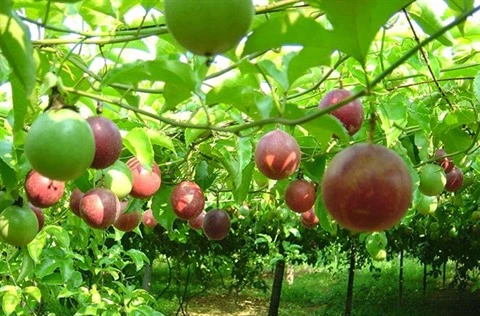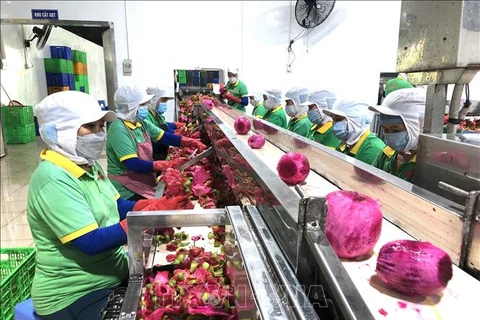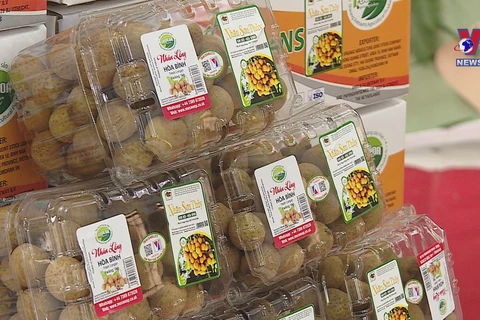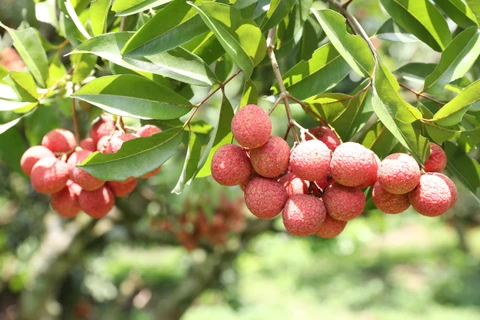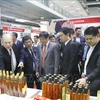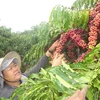Hanoi (VNA) - Vietnam holds huge potential for fruit production, but food safety requirements may be among the major challenges to the country’s export of the products.
Nguyen Thi Thu Huong, Deputy Director of the Plant Protection Department under the Ministry of Agriculture and Rural Development, said to receive permission from the General Administration of Customs China regarding the import of fresh passion fruit from Vietnam, the Chinese agency recommends that related growing areas and packaging facilities must follow good agricultural practices, monitor pests and pesticide residue, and ensure safety and hygiene for COVID-19 prevention and control, among others.
Meanwhile, technicians involved must be trained to take control of the entire production and packaging process.
Farmers and firms have been notified that similar conditions have been set for other fruits to be exported via official channels to China.
However, a number of challenges currently stand in the way of meeting safety requirements.
In late 2019, Japan’s Ministry of Agriculture, Forestry and Fisheries announced the opening to Vietnamese lychee, with regulations in for quarantining the fruit. It was great news for Bac Giang province’s Luc Ngan district, known as the “Kingdom of Lychee” in Vietnam.
[Vietnam’s quest to turn fruit export potential into power]
To receive permission to enter Japan, the fruit must fulfil more than 830 herbicide residue requirements together with about 180 others on production and packaging, said Nguyen Thi Thanh Thuy, a technical officer at the district’s Technical Centre for Agricultural Services, in a telephone interview.
In addition, plant quarantine time may take up to 30 days, amid the constant risk brought by pests and diseases. During that time, farmers need to take measures to protect their trees against those threats, and simultaneously must ensure that residues do not exceed the maximum limits.
"It takes extra effort, care and cost to carry out all of the tasks, along with growing worries about unstable output if their fruit is ruled out for export," Thuy added.
If one or two samples sent to the quality control centre fail to meet just one requirement, the whole batch will be rejected.
Therefore, efforts have been made to raise awareness to meet requirements of foreign markets and offset possible harm to farmers as well as the country’s fruit brand and sustainable economic power.
To conquer a choosy market like Japan, lychee is grown at Luc Ngan orchards under the supervision of specialists from the Plant Protection Department with origin-tracing codes.
Lychee trees are cultivated according to Vietnamese Good Agricultural Practices (VietGAP) standards, with stricter procedures in caring time, including the use of pesticides on a permitted list, and with a number of standards to be met during harvesting.
Phytosanitary regulations and food safety standards in Japan must be thoroughly met, and a certificate issued by the Department is enclosed with lychee shipments to the country.
Stakeholders commit to complying with the requirements in each step to make sure the fruit meets all criteria when they are still in Vietnam. "As a result, since Japan officially opened its door to Vietnamese lychee in 2019, no shipments have been turned back," Thuy proudly said.
Furthermore, international partnerships can also help Vietnam strengthen safe fruit production and exports.
Communication between representatives from export markets and Vietnamese stakeholders will help the latter better understand the requirements and apply suitable measures, plus receive adequate support if needed.
Luc Ngan authorities have also worked with Vietnamese embassies abroad and invited domestic businesses with links to foreign partners to select growing areas with traceability codes, as required by import procedures in Japan and the US. Japanese experts carry out inspections of orchards.
Meanwhile, New Zealand’s ongoing development programme in Vietnam has a number of agricultural projects, including a premium fruit development project in the Mekong Delta province of Tien Giang.
 Stakeholders of a fruit development project in Tien Giang province backed by New Zealand pose for a photo (Photo courtesy of the New Zealand Embassy in Vietnam)
Stakeholders of a fruit development project in Tien Giang province backed by New Zealand pose for a photo (Photo courtesy of the New Zealand Embassy in Vietnam) Vietnam has proposed that New Zealand assist the Southeast Asian nation with the building of a supply chain for dragon fruit, as the Oceania country has gained global success with its kiwi.
Vietnam boasts the largest dragon fruit acreage in the world, with 49,000 ha. The fruit grown in Vietnam has found a place on shelves in 40 countries and territories.
Actions have been taken to gradually change producers and exporters’ mindsets, from being content with just ‘sufficient’ and ‘delicious’, to taking ‘safe food’ into account.
And ensuring food safety requirements will be a decisive factor for Vietnam’s exports to reap future rewards, given the quality and safety of products always serve as a cornerstone./.





